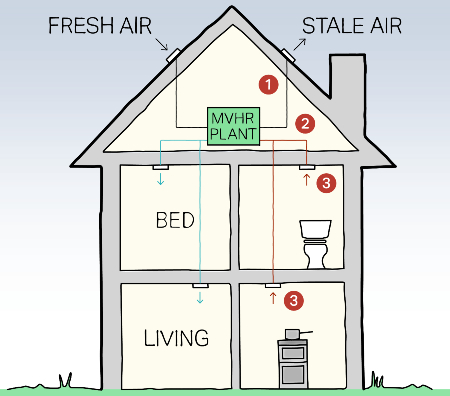
1. All extract is taken through a single outlet which can be discreetly located on the building, for example at roof level.
2. Ductwork will be required to connect the various extract outlet locations to the MVHR plant. Some slimline systems are available which can fit inside partition and ceiling voids.
The mechanical ventilation and heat recovery plant can be installed in a concealed location such as a cupboard or roof space.
3. Extracts from kitchens, toilets, and utility rooms at lower floors, and bathrooms, shower rooms, and en-suite’s at upper floors can all be connected to the mechanical ventilation and heat recovery system.
Mechanical ventilation and heat recovery systems (MVHR) combine the various extract fan functions in a home with a small heat exchanger. This takes warmth from the waste air being removed and uses it to heat the incoming air which is replacing it.
MVHR is very effective at tackling condensation and air quality which is a major risk factor when improving energy efficiency, especially in historic buildings.
For MVHR systems to be effective, the home must be airtight. In draughty homes they are less beneficial because the uncontrolled air provides enough vent. In well sealed homes the MVHR provides a reduction in heating energy at the expense of some fan energy, and helps to make sure there is enough ventilation.
Passive systems are also available which use wind pressure and thermal stack-effect to naturally move air through the system and these can be useful in some situations where the benefit is otherwise marginal.
As will all ventilation improvements, there are potential benefits to health for households with damp problems.
The cost-benefit ratio of the MVHR system depends on the home being airtight. In addition to the cost of the system, you would also have to consider the cost of professional instalment, and the cost of filter replacements.
Listed Building Consent is required to install and for an extractor fan or heat-recovery ventilation system.
Excessive moisture levels can lead to condensation and mould and bacterial growth, which can be harmful to historic building fabric and human health, so controlled ventilation is recommended. MVHR is a very effective way of reducing moisture levels to avoid condensation.
Principal elevations should be avoided. Where it can be successfully justified that there is no alternative, discreet outlet styles and colours will be of paramount importance.
Specify an outlet of a discreet style and colour that matches the surrounding wall colour as closely as possible.
If possible, offer to remove redundant services from the wall where they are no longer required as a conservation gain.
Consider locating the exhaust through a vertical flue in a roof that cannot be seen.
We support the installation of air source heat pumps where there is no detrimental impact on the architectural or historic interest of the building, and they can be discreetly located.
In the light of the Climate Emergency, we will generally permit and encourage alterations on listed buildings, with special regard to the the following:
- Preserving the building, its setting or any features of special architectural or historic interest which it possesses
- Preserving or enhancing the character of a conservation area
- Respecting the significance of any non-designated heritage asset
The Domestic Building Service Compliance Guide (2010) is available free from the Planning Portal.
Natural ventilation guidance for traditional buildings from buildingconservation.com
